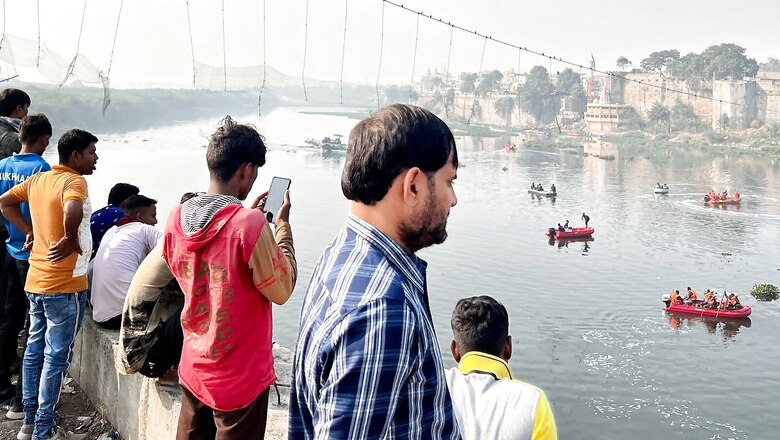
views
The Morbi bridge collapse in Gujarat during the Chhath Puja celebrations underlined that a dilapidated structure, people’s callousness and mismanagement is the perfect recipe for disaster.
What followed after the tragedy was the disaster response teams, Army, Air Force and Navy rescuing those who tumbled into the Machchhu River, arrest of nine persons, including four from the Oreva group that was managing the Morbi suspension bridge, and a case filed against the firm that was maintaining and operating the British era structure.
The FIR stated “gross negligence” and “careless act of mismanagement, and that “despite knowing the threat to the life of citizens posed by the bridge, the bridge was opened on October 26”.
After Prime Minister Narendra Modi called for “detailed and extensive” probe into the tragedy, which killed 135 people, five lapses have come to the fore. First, that it was a rushed job to open the bridge early on Gujarati New Year than December, which was the original plan; second, the renovation of the bridge with aluminium layers and flooring added to the weight of the bridge; third, unqualified sub-contractors were supervising the repair; fourth, nobody was managing the crowd on the bridge, which was beyond its capacity; fifth, the Oreva Group did not have any rescue plan in place in case of a mishap.
While the small fishes have been arrested, would the big ones be caught this time? Let’s see what action was taken by the authorities in the past bridge tragedies.
Elphinstone Foot Over Bridge, Mumbai, September 2017: Nearly 23 people, and 39 were injured in the stampede, which was caused by overcrowding at Elphinstone local railway station’s FOB. The tragedy raised several questions such as why was the development plan of Parel station was stuck for years, why was no heed paid to the railway activists’ warnings? A high-level committee of Western Railway had absolved the staff of any responsibility. The Dadar Police too did not find any foul play or negligence on part of any individual in the tragedy.
Kamala Mills Fire, Mumbai, December 2017: A fire broke out at Mojo’s Bistro restaurant inside Kamla Mills compound, killing 14 people and injuring several others. Although the Mumbai sessions court on November 2020 discharged the owners of the Kamla Mills compound, it did not relieve the owners of the restaurant, BMC officials and others. The owners of the compound said they cannot be booked for the incident as they had no connection with it. The other nine face charges of culpable homicide not amounting to murder under Maharashtra Fire Prevention and Life Safety Measures Act, 2006.
Amritsar Train Disaster, October 2018: At least 60 people were killed and 72 injured after a train ran into a crowd of those enjoying Dussehra celebrations in Amritsar in Punjab. The organisers were booked but no action was taken against those who organised the event.
ESIC Hospital Fire, Mumbai, December 2018: At least five people died, including a five-month-old baby, after a major fire broke out in the five-storey hospital in Andheri East. Two welders from Bihar and two junior-level officers of a private firm conduction construction work were arrested. No official of the Maharashtra Industrial Development Corporation was held accountable.
CST Foot Over Bridge Collapse, Mumbai, March 2019: Six people were killed after a portion of the foot over bridge caved in. The bridge cleared as ‘fit’ by a private firm despite having structural flaws. Although a high-level enquiry was ordered into the incident, no BMC official was booked. Only junior-level officials of local municipal bodies were arrested.
Read all the Latest Explainers here



















Comments
0 comment